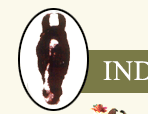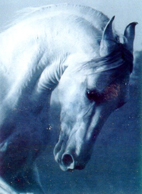


|
The Horse Breed Standards
Chamurti Pony The Chamurthi is a small mountain pony of the Indian Himalayas, regarded as a distinctive breed. The Chamurthi belong to two main areas in the Indian Himalayas. The pin valley,with its several villages,to the southwest and the villages of Kibber and Chichem, to the northeast of the town of Kaja(Kaza)that lies along the Spiti River in the District of Lahaul-Spiti,Himachal Pradesh.Although primarily inhabting upland plateau of 5,000 meters or more,it is also bred and used as low as 800 meters.It is well adapted to the temperatures extremes of the ‘cold desert’ regions of Spiti and northwards in Ladakh where temperature range from -30 degrees C.to +30 degrees C. CHARACTERSTICS HEIGHT Relatively consistent in size,the chamurthi ranges in height from about 11h.2” to13h.2”. Although regarded locally as a horse, in Western terms it is a pony, i.e under 14.2h.h. CONFORMATION The Chamurthi has a good bone structure and is well muscled. Its chest is deep and the shoulders are slightly sloped.The withers are low and the back is short,but it tends to have a high, almost straight, backbone, rather than one that slopes gently down from the withers and up again to the rump.Its legs are short and sturdy.Its displays a range of head features tending to the heavy side,with small to medium eyes and ears. COLOURING While its size may be consistent its colouring and markings are not, Chamurthi come in a range of colours and shades,from black to light grey , palamino yellow to sorrel brown, chestnut and bay. DISTINGUISHING FEATURES Its distinguish features are:-
Perhaps its most distinguish feature, and the source of its value to riders, is that it is one of the worlds few natural “pacers” a five-gaited horse,that trots on its laterals rather than diagonals enabling the rider to sit comfortably without posting while the horse trots on for two or three hours at a time. BREEDING The source of the breed is unknown although it has much in common with the Tibetan horse.Given the fact,however than horses existed in the Himalayas, at least as early as the Indus Valley (Harrapan) Civilzation the Chirmurti could well be indigenous to northern India. As noted above, both the Asian wile horse, and the Arabians seem to found their way into the bloodline. For the most part,the Chamurthi live and breed in their upland Spiti plateau,or jungles where they are left alone except when needed for work.Their progeny,for the most part,are the result of whichever stallion dominates the mares in the herd at the time. Selective breeding,and with it the possibility of keeping stary non Chamurthi mares and stallions out of the bloodline may be practiced by some of the Buddist gompas in Spiti where horses are maintained for riding and carrying; and a stallion is kept. Also some individual owners may select either the stallion or mare of their choice in order to try to have the kind of foal they wish for,otherwise one has to run to the Himachal Pradesh Animal Husbandry Department’s Breeding station at Lari District Lahaul &Spiti and a second run by Indian Army, 30 kms from Leh-Ladakh. TRAINING They are trained for packing and riding,according to traditional practices by their families,whose secrets are handed down from generation to generation. Chamurthi ponies, growing up alongside their mothers whom they follow up and down over rocks, along mountain tracks and crossing rivers at high altitudes rapidly develop sure footedness and an ability to travel long distances in difficult terrain. USE The chamurthi pony has been used by horsemen / traders of Spiti to carry goods between India and Tibet.As this activity ended with the Chinese invasion of Tibet and the subsequent closing of the border with India. The chamurthi are now largely traded for jewellery,rugs and pashmina wool with the Changpa nomads who inhabit on the Chang-tang that part of Tibetian plateau which extends into eastern ladakh.The Chamurthi are also used by the Indian Army on mountain tracts that are inaccessible to motor vehicle. EFFORTS OF THE GOVT.TO PRESERVE THE BREED Department of Animal Husbandary is running at Chamurthi Horse breeding Farm in the native tract of these horses at Lari in Distt.Lahaul and Spiti .Total area of the Farm is 22.77 Hectare and at present 24 horses are being rared .Farm has been started with a view to conserve the Chamurti horses so that the breed is saved from becoming extinct. Farm is being used for propagation of these horses and only surplus progeny is being sold. During year 2002,Royal Army of Bhutan purchased 10 Chamurti horses from this farm.Indian Army is also running a spiti horse farm some 30 km from Leh. This Farm is being strengthened under centrally sponsored Scheme “Conservation of Threatened Breeds of Livestock.”The GOI has released a sum of RS.59.00 lakh out of 45.55 lakh has been spent on construction of sheds,paddock,hay store,wages,feed and fodder etc. According to 2003 livestock census population of horses and ponies in H.P is 17,144 Separate census figure for chamurti horses is not available. |

